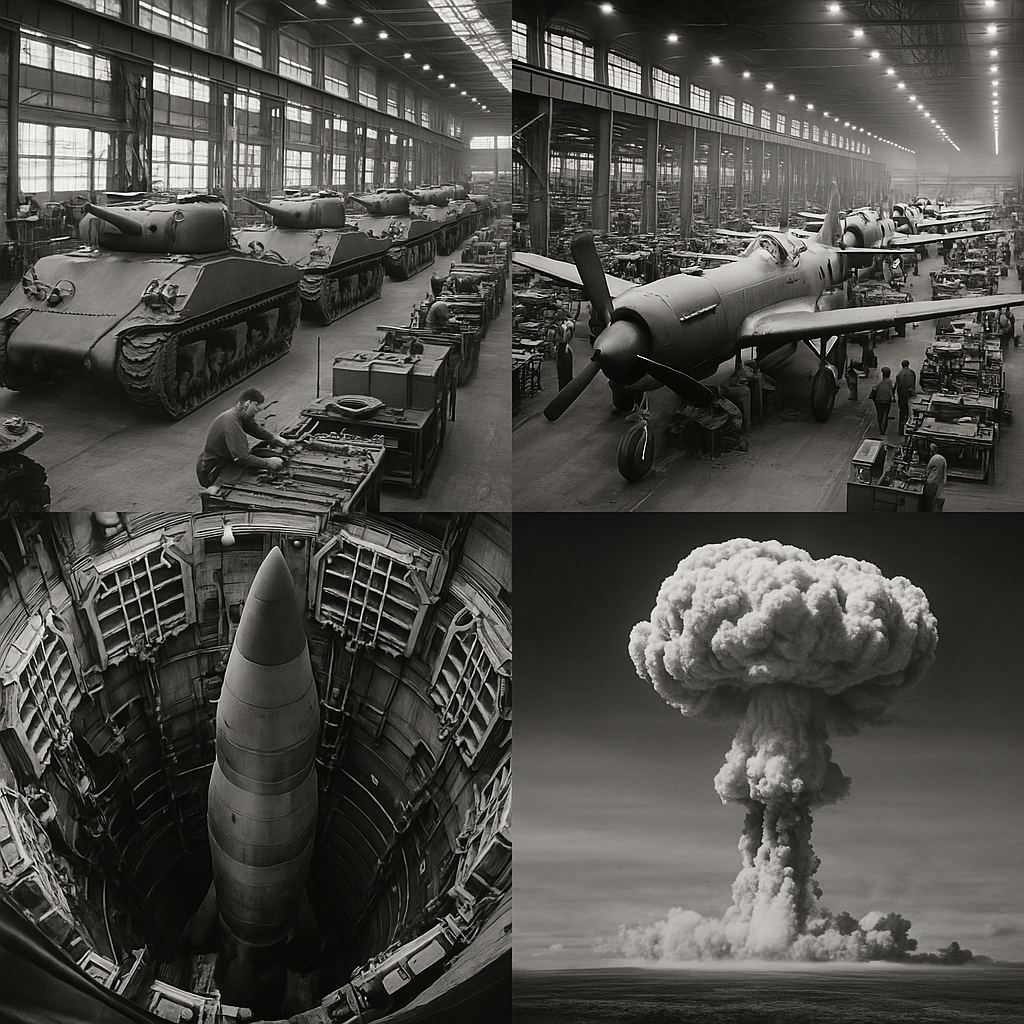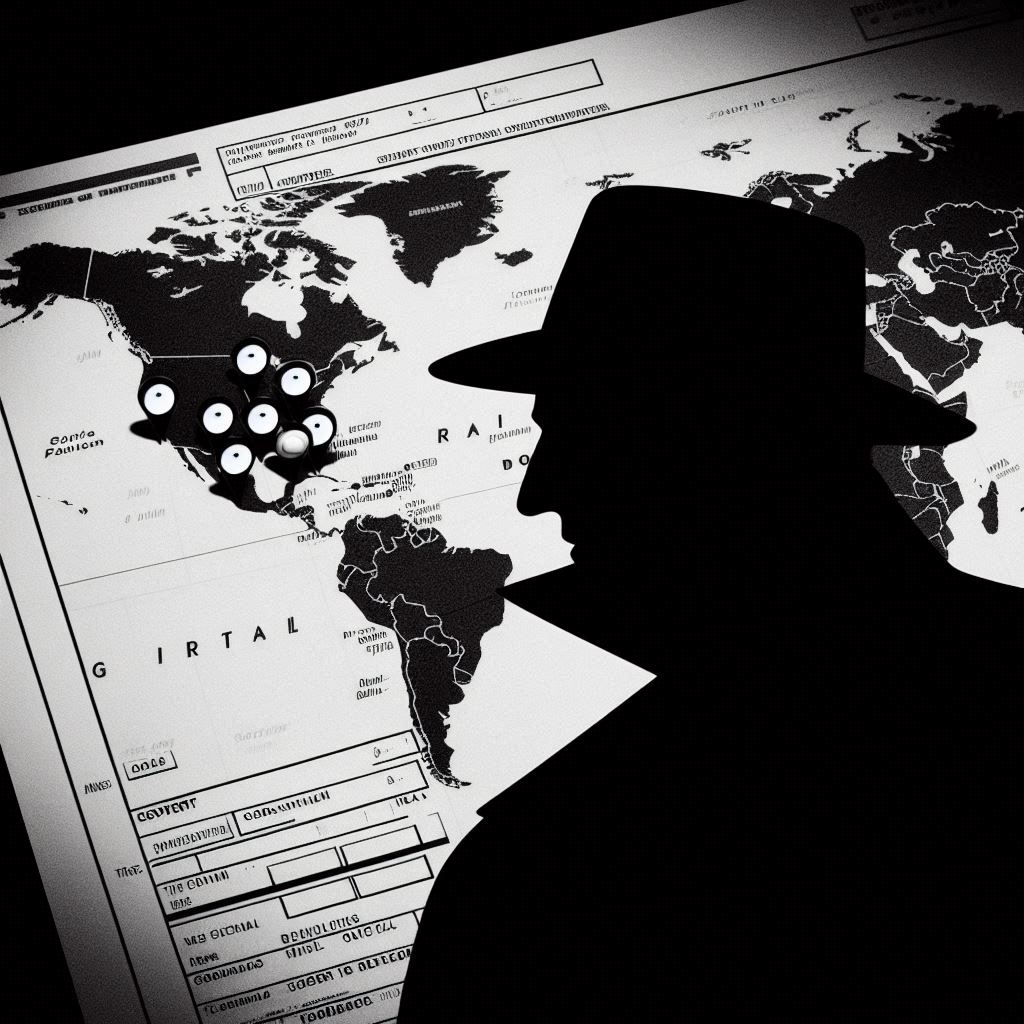Part 1 of 6 in the American Military-Industrial Complex Series
- Part 2 of 6:

An Unsettling Question: Who Truly Pulls the Strings?
Many view global geopolitics as a grand chessboard. They believe statesmen and diplomats play this game, nobly pursuing national interests and global stability. In this view, it’s a complex dance where the brightest minds aim for peace and prosperity.
However, is this carefully built image merely a false front? Could it be a comforting illusion hiding a much darker reality? Consider if the most influential players operate in secret. Imagine their moves are driven not by public welfare or peace, but by an unquenchable thirst for profit and power.
Furthermore, what if the game itself is rigged? It might be designed to sustain conflict, ensuring that a select few continuously profit under the self-righteous banner of “national security.” This six-part series dives into the complex world of the American Military-Industrial Complex (MIC). Our goal is to bring these hidden players, their tactics, and their destructive results into clear view.
Dwight D. Eisenhower was a five-star general who led the Allies to victory in World War II. Later, as President, he was far from a naive idealist. Indeed, he understood war’s grim necessities and the harsh realities of international power.
Despite this, in his 1961 farewell address, Eisenhower delivered a stark and forward-looking warning. This warning has resonated with growing urgency over the decades. He highlighted the new “conjunction of an immense military establishment and a large arms industry” in America. Crucially, he cautioned against the “acquisition of unwarranted influence, whether sought or unsought, by the military-industrial complex.”
Eisenhower expressed fear that “the potential for the disastrous rise of misplaced power exists and will persist.” As a seasoned warrior, he recognized this emerging threat. He understood its power to distort American democracy and turn a republic into an empire fueled by constant war. Unfortunately, his warning went unheeded; instead, it became a prophecy.
This series offers an unflinching look at how Eisenhower’s prophecy came true. We will journey through history, starting from the post-World War II era where the MIC’s seeds were planted. Then, we will move to the present, where its influence touches nearly all aspects of American foreign and domestic policy.
Our investigation will dissect how a system, supposedly built for national defense, has transformed. It has become a self-sustaining entity. This entity profits from conflict, engineers public agreement, and makes huge gains from global bloodshed and instability.
Moreover, we will introduce key themes that appear repeatedly. These include the subtle spread of hidden power and the rise of political families closely tied to war industries. We also examine the cynical use of modern conflicts and the oppressive secrecy after 9/11 that protects these operations from public view.
We must face a central, uncomfortable question: Is “national security” a true shield for the American people? Or has it become a sword used by the MIC for its own wealth and power?
Consider this: Is our soldiers’ blood and our nation’s treasure spent to protect our freedoms? Or does it fuel a machine demanding endless war? The line between real defense needs and greedy profit-seeking has become dangerously unclear. This blurring might even be intentional. It’s important to state that legitimate defense needs do exist in our complex, often dangerous world.
Consequently, we will examine U.S. interventions. These actions are often presented as noble efforts to spread democracy or protect key interests. However, they frequently destabilize entire regions and create resentment. This, in turn, can lead to “blowback,” which then justifies more military spending and intervention. This creates a perfect, closed cycle of violence and profit.
The Genesis of the Beast: From Post-War Necessity to Permanent War Economy
The American military-industrial complex did not appear suddenly. Its origins trace back to the intense pressures of World War II. During this time, the “Arsenal of Democracy” defeated fascism. This victory required a massive build-up of industrial power and close teamwork between government, military, and private companies.
Initially, this partnership was a necessary alliance. However, after the war, the established infrastructure, relationships, and overall mindset did not just disappear. Soon after, the Cold War emerged. It brought the threat of Soviet expansion and nuclear destruction. This environment became the ideal breeding ground for the young complex to grow, establish itself firmly, and become a lasting part of American life.
Fear as Fuel: Solidifying Power

Fear quickly became a powerful tool. The threat of communism, often overstated and twisted, was used to justify huge defense budgets. It also supported a growing, secretive intelligence system and a foreign policy that increasingly depended on military force.
A key moment was the National Security Act of 1947. This major law established the Department of Defense, the National Security Council (NSC), and the Central Intelligence Agency (CIA). These bodies were supposedly created to improve national security coordination. However, they also gathered enormous power, often with little supervision.
For instance, as our second article on David Talbot’s “The Devil’s Chessboard” will detail, figures like Allen Dulles played a key role. As the first civilian Director of Central Intelligence, Dulles helped shape the CIA into a tool for secret operations. He combined corporate interests with government power and favored a hidden, often violent, method in foreign affairs. Consequently, the belief in achievable peace faded. It was replaced by a strategy of constant watchfulness, readiness, and, by implication, unending conflict.
This period also saw the establishment of what C. Wright Mills called the “power elite.” This group consisted of military, corporate, and political leaders whose interests grew more and more connected. The “revolving door” soon became common. This is where top military officers and government officials easily move into well-paying jobs in defense companies, and the reverse also happens.
This close relationship means that those who benefit most from war and military growth often shape, or even control, policy decisions. As a result, defense contractors turned into powerful lobbyists. They influenced laws and elections, securing a constant flow of government contracts, often without regard for actual security requirements.
Furthermore, promises of jobs in local districts, the appeal of superior technology, and constant fear-based messaging created a political atmosphere. In this climate, questioning the MIC’s endless hunger was seen as almost treasonous.
Key Themes on the Global Chessboard: Power, Dynasties, and Perpetual Crisis
As the MIC strengthened its power, several key themes emerged. These patterns of behavior define its operations even today. Understanding these themes is vital for recognizing the moves made on the global chessboard.
Theme 1: Covert Power and Secrecy

A primary theme is the dependence on hidden power and secrecy. Intelligence work and special operations naturally require some level of discretion. However, the MIC has systematically used this need for secrecy. It does so to hide its more harmful actions from public and congressional review.
For example, coups, assassinations, arming proxy forces, and meddling in foreign elections have all occurred under the guise of national security. These actions often lead to terrible long-term results. When we look at the CIA’s early days under Dulles, we see this clearly. Operations in Iran (1953) and Guatemala (1954) were done to protect corporate interests like the Anglo-Iranian Oil Company and United Fruit Company. These actions not only overthrew democratic governments but also planted seeds of anti-American feelings that still cause problems today.
Ultimately, secrecy allows for actions without punishment. The MIC has skillfully used this to work outside the usual checks and balances of a democracy.
Theme 2: Political Dynasties and the MIC
A second disturbing theme involves political families. These dynasties play a role in continuing and profiting from the MIC. Russ Baker, in “Family of Secrets,” carefully shows how certain families seem deeply embedded in the military-intelligence-industrial system.
The Bush family is a key example, with strong connections to intelligence, oil, and defense contracting. Consider George H.W. Bush’s time as CIA Director and later as President during the First Gulf War. Then, look at George W. Bush’s “War on Terror” and the Iraq invasion. The family’s path has been closely tied to growing American military power and the wealth of related industries.
This situation is not just about personal ambition. It involves building networks, developing influence, and making a certain viewpoint normal. This viewpoint sees military action as the standard solution and war as a practical, even preferred, economic driver. Our third article will focus on this theme.
Theme 3: Exploiting and Manufacturing Conflicts

Thirdly, the MIC shows great skill in using existing modern conflicts and even creating new ones. For example, the Soviet Union’s collapse in 1991 should have led to a “peace dividend.” This means military spending should have significantly decreased, with a move towards diplomatic answers. Instead, the MIC looked for new enemies and new reasons for its existence.
The “War on Terror,” started after the shocking 9/11 attacks, offered a perfect chance for the MIC. Peter Dale Scott, in “The Road to 9/11” (our fourth article’s focus), argues that these events were used to enact existing plans. These plans involved military growth and reducing civil freedoms. The idea of a “deep state” working behind the public government, along with Continuity of Government (COG) plans, points to a hidden system. This system seems ready to use crises to push its own goals. As a result, the Patriot Act, widespread surveillance, and unending wars in Afghanistan and Iraq became standard. These fueled the MIC with trillions of dollars and unmatched power.
This pattern brings us to today’s global situation, especially the Ukraine conflict. Scott Horton and Darryl Cooper argue in “Provoked” (our fifth article’s topic) that this war is not a standalone event. Instead, it’s the result of decades of U.S. and NATO actions that provoked Russia. NATO’s eastward growth, meddling in Ukrainian politics, and intentionally increasing tensions can be viewed as the MIC’s latest move. This strategy creates a new enemy and a new area for profit and influence. While the story of defending democracy is powerful, it often hides the familiar tactics of a complex seeking its next gain.
The Razor’s Edge: Legitimate Defense vs. Predatory Profiteering
We must recognize that the world can be dangerous. Real threats, such as hostile states, terrorist groups, and unexpected crises, are present. These dangers require a strong national defense and an effective intelligence system.
The men and women in our armed forces and intelligence agencies often serve with great courage and dedication. Many genuinely want to protect their country. Their sacrifices are significant, and their commitment earns our deepest respect. Importantly, this series does not criticize these individuals. Nor does it call for one-sided disarmament or a naive withdrawal from global duties.
However, the MIC has skillfully used this genuine need for security. It constantly blurs the line between defense and attack, and between real needs and taking advantage of situations. Often, “threats” are exaggerated, created, or even intentionally provoked. This is done to justify steadily rising budgets and military actions.
Furthermore, developing new weapon systems, which often cost billions, is not always driven by strategic necessity. Instead, lobbying by contractors and the aim to keep a technological advantage often fuel this development. This pursuit of an edge can, by itself, appear aggressive to others.
Additionally, the MIC’s foreign actions often result in “blowback.” These are the unplanned, negative outcomes of intervening in other countries. For instance, the CIA supported the Mujahideen in Afghanistan against the Soviets in the 1980s. This support, however, helped create conditions that led to Al-Qaeda and the Taliban.
Similarly, the invasion of Iraq, which was based on false claims, destabilized the entire Middle East. It also led to the rise of ISIS and caused a refugee crisis affecting the whole world. These events are not unique; they are repeating patterns. In its quest for quick goals and profits, the MIC often plants the seeds for future wars. This ensures its own ongoing importance and financial gain.
Ironically, the very enemies the MIC claims to shield us from can sometimes be the direct or indirect results of its past activities. This cynical cycle guarantees that the demand for “security,” along with the associated weapons and wars, never fades.
The Devil’s Advocate: A Necessary Evil in a Perilous World?
Some might argue, perhaps convincingly, that the American MIC is a necessary evil, despite its flaws. Our world contains autocratic governments, unpredictable states, and skilled opponents. In such a world, can the United States truly manage without the strongest military and the most widespread intelligence network?
It’s possible that the MIC’s harsh efficiency and its global power projection are exactly what have prevented larger wars. Perhaps these factors have protected American lives and interests for many years.
Is it possible that secret operations, political tactics, and even occasional “dirty wars” are regrettable but vital parts of governing? Especially in an international system that is naturally chaotic? The argument suggests that idealism is a luxury. It claims the tough realities of power politics require a practical, sometimes cynical, strategy.
From this perspective, the MIC is just the instrument America employs to handle these dangerous situations. The profits, though possibly too large, are seen as just a side effect of securing national survival and global leadership. Moreover, the stability that American dominance offers, no matter how delicate, could be supported by this very complex.

Furthermore, the MIC employs many people. Millions of Americans rely on the defense industry for their jobs. Technological advances from military research often find uses in civilian life, helping society overall. For example, the internet and GPS show clear marks of military-funded research.
Could taking apart or greatly reducing the MIC harm national security? Might it also damage the economy and slow down innovation? These questions are challenging. However, they support the argument that the MIC, despite its hidden elements and moral gray areas, performs a crucial, though flawed, role.
Our military personnel—soldiers, sailors, airmen, and marines—stand ready to defend the nation. They depend on the equipment and support this complex provides. Is their mission, and their sacrifice, not deeply connected to its very existence?
The Unfolding Narrative: A Journey Through the Labyrinth
This article has prepared the ground. It outlined the American Military-Industrial Complex and raised key questions about its existence and impact. We introduced the idea of a chessboard—a game with global stakes, often hidden players, and frequently tragic results.
Future articles in this series will explore these topics more deeply. They will focus on particular historical times and important studies that aimed to reveal the MIC’s internal operations.
Our journey will start with the origins of the modern secret state, featuring Allen Dulles and the early CIA. We will explore how corporate power and spying became tightly connected. This connection laid the foundation for decades of hidden interventions.
Next, we will look at the Bush dynasty’s strong ties to the MIC. We’ll trace how political power and war profits became a family business. This solidified the complex’s influence at the top levels of U.S. government.
Then, the story will shift to the post-9/11 period. We will analyze how the “deep state” used a national disaster to launch a massive growth of military action, secrecy, and spying. This drastically changed the balance between security and freedom. Finally, we will move to current events, examining the Ukraine conflict as the newest part of the MIC’s long record of stirring up trouble and war for profit. This shows that the old methods are still being used.
Lastly, our final article will bring these ideas together. It will draw lessons from many decades of history. This piece will be a call to smash the chessboard—to reject the cynical game of endless war.
While we respect the real sacrifices of honorable military members, we will also make a strong appeal. We will call for openness, responsibility, and a major shift in American goals. This shift should move away from war profits and towards true human security and peace.

The path forward involves a careful review. This review balances respect for real national defense needs with a firm critique. We critique a system that has too often valued profit above people, and power above peace.
Our aim is not just to provide information. We also want to encourage thinking, question beliefs, and enable readers. We want you to challenge the official stories that support the MIC’s control. The shadows are dark, but we can see through them. It is time to expose the game and its players.
